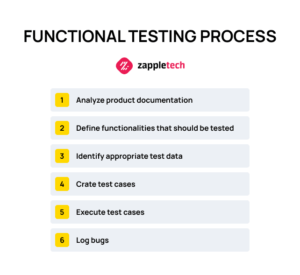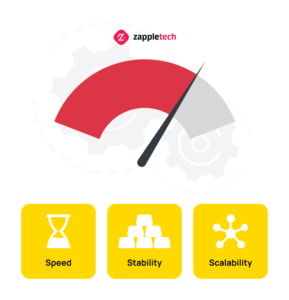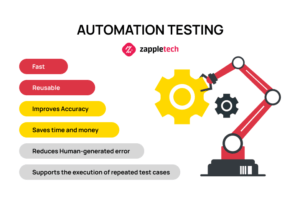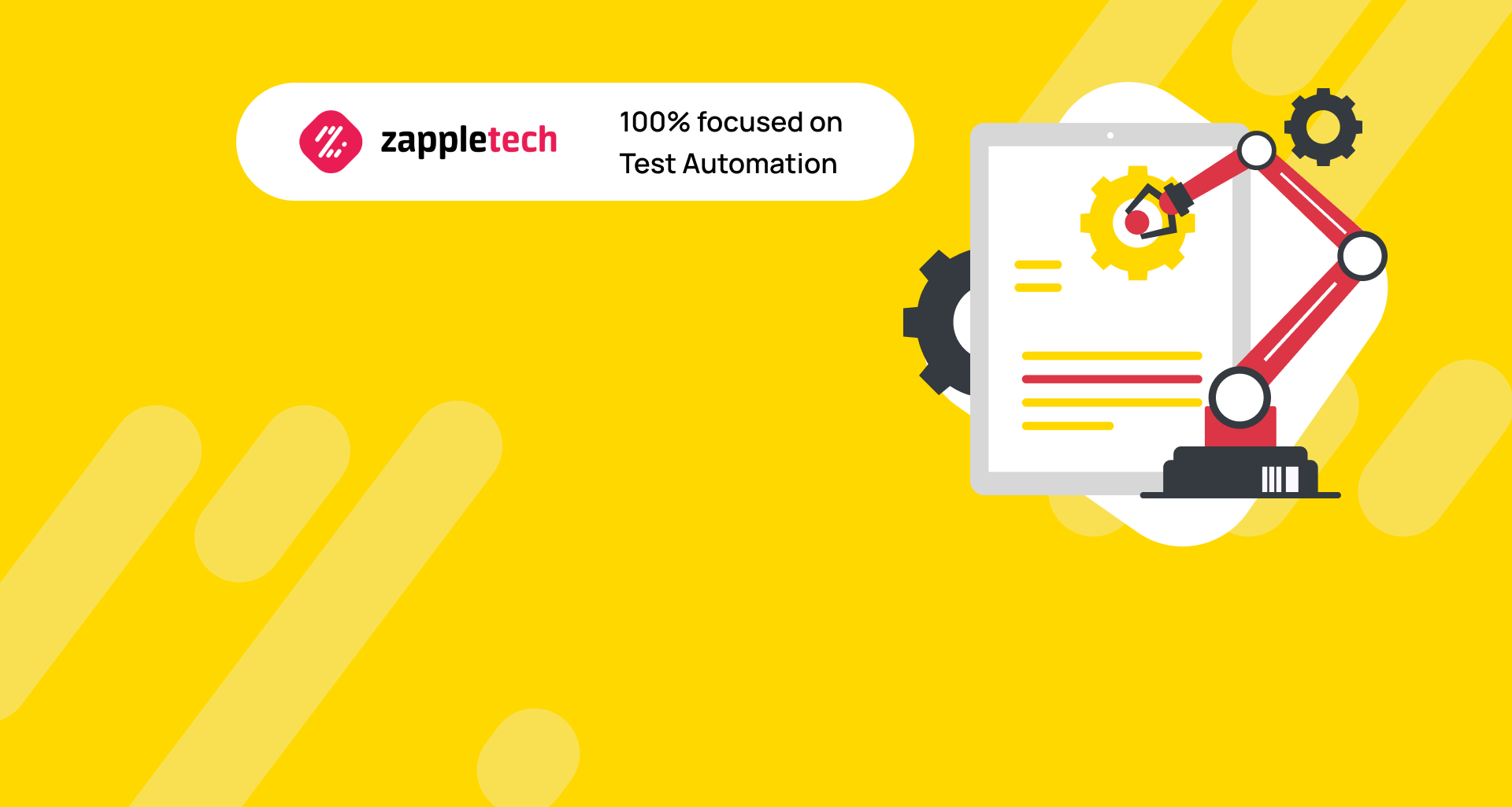Do you know the size of the global QA market? According to GMInsights, its value exceeded $15 billion in 2020. Analysts predict the annual growth of the niche by 16% by 2027. Agile and DevOps methodologies are leaders today, used by most IT product developers. These methods are not innovative, as they were developed as the result of many years of experimentation and modernization. Their key feature is automation, or rather the ability to automate almost all tests that are inefficient when provided manually: expensive, time-consuming, and impractical.
Test automation solves the main problem of SQA teams: it speeds up routine processes and optimizes the ratio of work/time spent on testing all the software features. ZappleTech experts conducted market research of QA technologies and methods, looking for best practices to improve the quality and speed up the QA testing process. Part of this research involved detailed analysis of test procedures in software testing, ensuring that every aspect of the software is evaluated thoroughly.
To give you a clearer picture, let’s delve into some of the key findings from ZappleTech’s research. One significant trend is the increasing reliance on AI and machine learning to enhance test automation frameworks. These technologies enable predictive analytics, which can foresee potential issues before they become critical, thus reducing the time spent on debugging and fixing.
Identify and automate repetitive and time-consuming test cases. Focus on areas like regression testing, which often consume a significant amount of manual testing time. By automating these, you free up your QA team to concentrate on more complex scenarios.Mykhailo PoliarushCEO, ZappleTech Inc.
Moreover, continuous integration and continuous deployment (CI/CD) pipelines have revolutionized the way software testing is integrated into the development process. By automating test procedures in software testing within CI/CD pipelines, teams can ensure that every new code commit is automatically tested, leading to faster detection of issues and more reliable software releases.
Additionally, the shift towards cloud-based testing environments has provided QA teams with the flexibility to scale their testing efforts dynamically. This means that test procedures in software testing can be executed on various configurations and platforms, ensuring comprehensive coverage and robustness of the software under different conditions.
The result is this material, and we want to share it with you, dear readers. Grab your coffee and croissant, make yourself comfortable, we’re getting started!
Table of Contents
QA testing process: the path to excellence

The idea of quality control is as old as the world. It began to be implemented in the 1980s when Waterfall was the predominant methodology. In those days, QA specialists did their job in the later development stages and tested almost complete products. As a result, they would detect bugs that required rewriting the application code from scratch, which wasted the time and money of developers and customers.
However, as software development evolved, so did the approach to quality assurance. The introduction of Agile methodologies brought significant changes, emphasizing the importance of early and continuous testing throughout the development lifecycle. This shift led to the development of more structured and efficient test procedures in software testing. These procedures now include various testing types such as unit testing, integration testing, system testing, and acceptance testing, all aimed at identifying and fixing issues as early as possible.
The evolution of test procedures in software testing also saw the rise of automated testing tools and techniques. Automated testing helps in executing repetitive test cases and can significantly reduce the time required for testing large applications. It ensures that code changes do not introduce new bugs, thereby maintaining the software’s quality over time. Moreover, the integration of continuous integration and continuous deployment (CI/CD) pipelines has further streamlined the testing process, allowing for faster feedback and more frequent releases.
In summary, the journey from traditional quality control to modern test procedures in software testing reflects the industry’s ongoing commitment to delivering high-quality software efficiently and effectively. By embracing these advancements, software development teams can mitigate risks, reduce costs, and ensure a better user experience.
Usually, it was solved in three ways:
- Restarting production and rebuilding software considering past experience and bugs found. As a result, after several iterations of edits, applications were released, ready to conquer the wallets of users.
- The product was produced “as is”, i.e., with mistakes. Developers released patches to fix most of the performance or interface problems. This approach drew criticism and rarely paid off the investment.
- If the bugs were not critical, software was released without editing and revisions, causing public outrage. Of course, raw IT products were almost not in demand and ruined the customers’ business and the reputation of the performers.
By the beginning of the 2000s, development had completely changed, and flexibility and adaptation had become priorities. The concept of “shift left” came to QA along with simultaneous testing and coding. The entire software development roadmap was divided into so-called sprints. This approach implied defining functions to implement and check for errors immediately. At the same time, regression testing was introduced into QA, which ensured more control over the quality of an IT product.
The only drawback was the work speed. Regression testing required a cyclical repetition of actions and more resources from QA teams. Fortunately, the situation changed again in 2010. Testers learned how to create automated scripts to reproduce real actions in a test environment. This is how test automation came to QA.
QA processes and procedures: from preparation to implementation
ZappleTech experts work in the QA field, so they thoroughly know how testing IT products with Agile and DevOps methods goes step by step. We have prepared for you a small excursion into the magic world of quality assurance, which is usually hidden behind the screen of perfectly implemented products. Let’s imagine a typical development cycle and define the role of the SQA team in a couple of sprints.
Preparation Phase
Before the testing phase begins, it is crucial to establish a comprehensive QA strategy. This involves identifying the scope of testing, selecting the appropriate testing tools, and defining the test procedures in software testing. During this stage, the QA team collaborates with developers and stakeholders to understand the project requirements and establish clear objectives.
Planning and Design
In this phase, test plans and test cases are created based on the requirements gathered during the preparation phase. The test procedures in software testing are outlined in detail to ensure all aspects of the application will be thoroughly examined. The QA team designs test cases that cover both functional and non-functional requirements, ensuring comprehensive coverage.
Implementation Phase
With the planning complete, the QA team proceeds to the implementation phase, where the actual testing begins. Test scripts are executed, and the results are meticulously recorded. This phase includes various types of testing such as unit testing, integration testing, system testing, and acceptance testing. The QA team ensures that all test procedures in software testing are followed meticulously to detect and report any defects or issues.
Choose tools that can easily scale with your project and support a variety of test scenarios, from unit tests to end-to-end tests. Tools like Selenium, Cypress, and TestComplete are versatile and can help streamline the QA process by providing comprehensive test coverage efficiently.Mikhail BodnarchukCDO, ZappleTech Inc.
Continuous Monitoring and Feedback
In Agile and DevOps environments, continuous monitoring and feedback are integral to the development cycle. The QA team works closely with developers to provide immediate feedback on any detected issues, allowing for quick resolution. This iterative process helps in maintaining the quality of the product throughout the development cycle.
Final Verification and Validation
As the development cycle nears completion, the QA team performs final verification and validation. This involves running regression tests to ensure that new changes have not adversely affected the existing functionality. The QA team also conducts performance and security testing to confirm that the product meets all specified requirements and is ready for deployment.
Deployment and Post-Implementation Review
Once the product is deployed, the QA team conducts a post-implementation review to evaluate the effectiveness of the test procedures in software testing. This review helps in identifying areas for improvement in future projects and ensures that best practices are continuously refined.
By meticulously following these QA processes and procedures, from preparation to implementation, ZappleTech ensures the delivery of high-quality IT products. Each phase is crucial in identifying and resolving issues early, ensuring that the final product not only meets but exceeds customer expectations.
QA process in software testing: automation tools
In past articles, we repeatedly mentioned such tools as Ranorex, Appium, Selenium, WinAppDriver, and TestComplete. They have similar functionality but differ in purpose, scripting languages, and supported testing platforms. Each tester chooses the toolkit based on their skill level and current tasks. There are also projects where the team is assembled based on the selected technical stack. However, even in these cases, there are options for QA processes and test procedures in software testing that help automate tests. These processes and procedures ensure the proper level of testing quality for both the code and the interface of IT products.
Implementing a robust QA process in software testing is crucial for maintaining high standards. Automation tools play a significant role in this process. Tools like Ranorex, Appium, Selenium, WinAppDriver, and TestComplete provide various capabilities that cater to different aspects of software testing, such as functional testing, regression testing, and performance testing. These tools help streamline the test procedures in software testing, making it more efficient and reliable.
A well-defined QA process involves several stages, including requirement analysis, test planning, test design, test execution, and test closure. Each stage has its specific set of tasks and objectives. Automation tools come into play during the test design and test execution phases. They enable testers to create and execute test scripts that mimic user interactions with the software, identify defects, and ensure the application behaves as expected.
Moreover, these tools support continuous integration and continuous deployment (CI/CD) practices by allowing automated tests to run as part of the build process. This integration helps detect issues early in the development cycle, reducing the cost and effort required to fix them. By incorporating automation tools into the QA process, teams can achieve higher test coverage, improve test accuracy, and reduce the time spent on repetitive testing tasks.
.
Speed up QA process: alignment and compromise

You know that the testing process rarely meets the deadline since some of the checks are often ignored by the QA team or postponed to the final sprints. As a rule, bugs in Agile/DevOps reach the release versions but in a much smaller volume than with the good old Waterfall technique. Is there a way to speed up SQA and meet the agreed development deadline? Yes. Our experts analyzed best practices and cases to prepare recommendations for optimizing the production process and ensuring proper quality control.
However, miracles do not happen in the real world and in IT development especially. Testing takes more than a matter of minutes, even with the most optimistic analysts’ forecasts. It is a painstaking and time-consuming process that requires the attention of all project participants. But with automation and parallelization, it can be significantly accelerated and optimized.
To do this, you need:
- Before starting the development, unite the team and make the project a priority for each participant.
- Prepare technical documentation to indicate the priorities and vital features of the IT product.
- Prepare a work plan considering the time spent on each cycle of coding and testing.
- Research the technical stack and choose the right tools to work with it.
- Write cases and test scenarios using black and white box methods, as well as scripts for regression checks.
- Follow the plan without deviating from the original structure.
- Automate all routine cyclical processes that slow down the SQA process.
- Parallelize testing for different platforms, run them simultaneously in the cloud or locally.
We believe that the described actions speed up the QA process and optimize teamwork. Of course, you can expand the staff and hire additional specialists, but it entails budget costs and introduces team inconsistencies. In modern realities, it is enough to have a small and cohesive group of QA experts who are experienced in automation, have a background in programming, and love their job. Our employees are a good example of this. We implemented dozens of projects for both startups and large business sharks. Therefore, we boldly assert that SQA requires involvement, practical skills, and a little experience.
QA release process: release is just the beginning of support

There is a myth that the routine stops with the release of an IT product, and the QA team becomes unnecessary. It is fiction from those who release raw solutions and don’t want to spend a budget on support.
Actually, the problems begin after the release because:
- Users do not know how the program works, so they use it improperly, breaking the debugged mechanisms.
- New bugs come along with improvements and updates, which appear in non-standard situations or use scenarios.
- If it is a web application or mobile software, performance decreases over time due to the increased load on the servers.
- There may be failures related to payment services or integrated modules, which also require prompt intervention.
- Sometimes, IT products are upgraded by in-house resources or other contractors, causing inconsistencies in the code, which leads to new problems.
- An app becomes outdated and requires cosmetic and technical repairs, which are best left to the original performers
As you can see, the QA team is needed even after the IT product is released to the market. Only specialists can quickly track the errors and pass them on to the developer. Timely fixing the app’s problem areas ensures further development and effective business operation.
Now you know in detail the problems of SQA in modern realities. If you have any questions, leave comments, and we will provide the necessary information. To keep in touch with our resource, subscribe to our news and add the website to bookmarks. See you soon, dear readers!
Conclusion
In conclusion, speeding up the QA process through automated tests is crucial for maintaining high-quality software while meeting tight deadlines. Automated tests streamline test procedures in software testing by eliminating repetitive tasks and reducing human error. This not only enhances efficiency but also ensures more comprehensive coverage, leading to more reliable software releases. By integrating automated testing tools, teams can focus on more complex testing scenarios and strategic initiatives, ultimately delivering better products to market faster. Embracing automation in test procedures in software testing is a strategic move towards achieving greater productivity and quality in software development.
Implement automated tests as part of your CI/CD pipeline. This ensures that tests are run continuously and issues are detected early, reducing the time spent on fixing bugs later in the cycle and speeding up the overall QA process.Sergey AlmyashevCOO, ZappleTech Inc.
Moreover, automated tests provide consistent and repeatable results, which are essential for identifying and addressing defects early in the development cycle. This proactive approach helps in minimizing the risk of critical issues in the final product, enhancing customer satisfaction and trust. Additionally, the ability to run tests continuously supports agile and DevOps practices, enabling faster iterations and continuous delivery.
Investing in automated testing also translates to long-term cost savings. Although the initial setup might require resources, the reduction in manual testing efforts and the faster identification of defects result in significant cost efficiencies over time. As test procedures in software testing become more streamlined and reliable through automation, teams can reallocate their efforts to innovation and improvement, further driving the competitive edge of the organization.
In summary, the adoption of automated tests is not just a technological upgrade but a strategic enhancement to the QA process. It empowers teams to deliver high-quality software rapidly, ensuring that test procedures in software testing are both efficient and effective. The future of software development is undeniably intertwined with automation, making it an essential component for any forward-thinking organization aiming for excellence.







